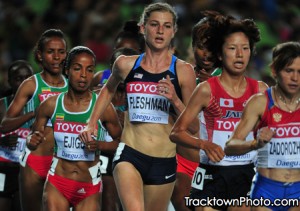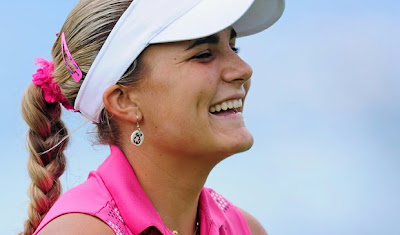It's been an interesting month for female athletes. Yesterday 16-year-old Lexi Thompson (who I have previously featured in a Shrinking and Pinking post in which I named her a "star of the future," which was clearly spot-on!) became the youngest ever winner of an LPGA event. While she's not old enough to join the LPGA tour (you have to be 18 to do that), she does get in the record books and take home a $195,000 pay check. Her father served as the caddy for this homeschooled high schooler-- and golf clearly runs in their family. Her eldest brother plays on the PGA tour, another brother plays for Louisiana State, and her mother played junior golf in South Florida.
Not surprisingly, golf is pretty competitive in their household. The New York Times reports: "Nicholas [the eldest] was the catalyst; his brother and sister grew up alternately emulating him and competing against him in high-stakes backyard chipping and putting contests. The loser would have to empty the dishwasher, take out the trash or perform some other hated chore."
I love the novelty of putting for chores, so I don't mind reading about those contests. But it is striking to me that the article gives just as much space to covering Lexi's looks as it does to these backyard contests: "Thompson, blond and nearly 6 feet tall, could be a cover girl for Golf magazine or Glamour. This weekend she received marriage proposals on the course and on Twitter. She is young and attractive and American, making her a coveted commodity on a tour that has been dominated in recent years by foreign-born players and that has struggled to maintain sponsorships and a full schedule." Even in the context of such a significant milestone, looks still matter in a pink athletic world.
A few weeks ago it was more significant when several markers and milestones did not fall in the world of women's athletics. Not one women's world record was broken at the Track and Field World Championships held in Daegu, South Korea. (My husband, a serious runner and track fan, got me hooked on the meets this year.) Women's records, and looks, remain an issue in this sport as well. I found this article on the lack of records in women's track fascinating. The author argues that women's records should be expunged because of suspected doping violations (suspected based on other cases, almost improbable performances, and, yes, women's looks). "Looks" in general remain an issue in women's track-- take the case of Caster Semenya-- but even she has not broken any world records.
Also not breaking any world records, but opening up an important discussion after her performance at Worlds, is Lauren Fleshman. Fleshman is a middle and long distance runner from the United States who finished seventh in in the 5000m at Worlds (my husband, showing an unexpected gossip-y side, informed me that when he was running college track/cross country Fleshman was the "hot running girl from Stanford").
Fleshman maintains a great website/blog and after the meet posted her thoughts on her performance. The most interesting part to me was the following comment at the end of her post:
"If you are a dude, be warned that the following paragraph contains feminine stuff:
The race fell on the absolute worst day of the month for my cycle, and I can’t help but wonder how I would have felt had that not been the case (I get 4 pounds heavier and sluggish at that time of the month). But maybe defending world champ Linet Masai is saying the same thing about her 6th place finish. Maybe the young Dibaba that I passed at the line had the flu. Defar had stomach problems. Molly Huddle had an injured foot. Our fastest American, Shalane, wasn’t even in the race. I guess that’s what championships are all about, and have always been about: unknowns and variables and who toes the line on the day. That spirit of championships will never change, and I wouldn’t change it if I could. But I would like to change my cycle next time, please. Or at least learn how to lesson the side-effects of bloating and water retention. Tips from other women with experience in this area would be appreciated! Thanks!"
The comments section is filled with interesting suggestions and tips that likely could help other female athletes. It also reminded me of a great piece from The New York Times on female athletes' menstrual cycles, which appeared earlier this summer. The Times article discusses several different studies on the effect of the menstrual cycle, and female hormones, on athletic performance. While it's not all bad, it's clear there is a reason that women in the 1980s supposedly took male hormones, and not female hormones, to improve their athletic outcomes.
While female athletes do need to negotiate the realities of their bodies, more gender lines are being crossed than ever before. In a show of some hometown love, Therea Scruton, a senior at Framingham High School, recently joined the boys' football team. Congrats and good luck to Theresa! (Though, of course, my favorite female high school football player remains college classmate Anna Lakovitch, who was a kicker for her Florida team. She now owns what looks to be an amazing restaurant, Ollie Irene, in Mountain Brook, Alabama, which you should check out if you are in the area!)
UPDATE: The day after I posted this blog, news broke that the international federation for track and field (the IAAF) had changed the rules for women's marathon world records. Essentially a woman can no longer set a record in a race run with men (presumably because the set pace will be faster). Well, ok, maybe... But that also means that they are changing the existing records on the books. So the "new" world record for a female marathoner is now slower than it was before, because the fastest was set in a race with men. I know sport has become increasingly numericized, and I don't think that is necessarily a bad thing. But this decision makes it harder both for fans to follow the sport and for athletes to promote and support themselves (for instance, if you can say you are the world's fastest woman at X, you will likely get more and better endorsements). This sort of promotion is especially important for women, I think, as men tend to get a lot of the attention. Yesterday The New York Times posted a story on this (head-scratching) decision near the top of their website, so I'd expect to hear more about this, especially in the lead-up to next summer's Olympics. The first line is especially powerful: "Now added to the list of banned performance-enhancing substances for female distance runners: men. "

